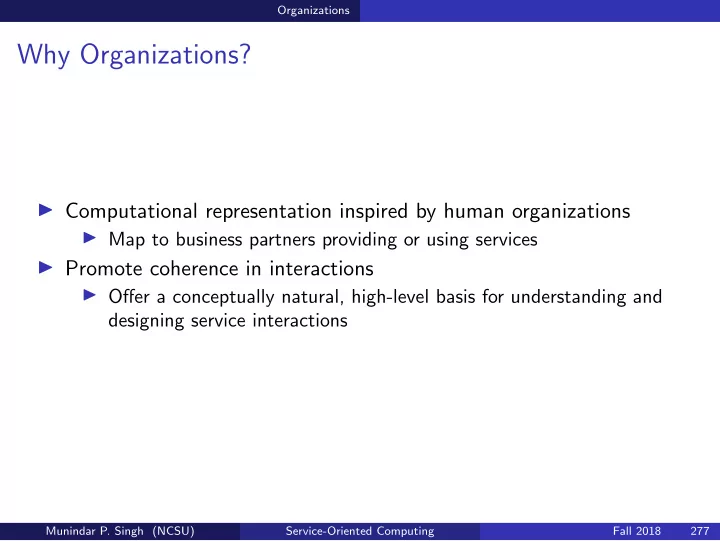

Organizations Why Organizations? ◮ Computational representation inspired by human organizations ◮ Map to business partners providing or using services ◮ Promote coherence in interactions ◮ Offer a conceptually natural, high-level basis for understanding and designing service interactions Munindar P. Singh (NCSU) Service-Oriented Computing Fall 2018 277
Organizations Organizations ◮ Organizations nest, though usually not as trees ◮ All organizations are agents ◮ Some agents are organizations ◮ Organizations help overcome limitations of individuals in ◮ Reasoning ◮ Capabilities ◮ Perception ◮ Lifetime, persistence Munindar P. Singh (NCSU) Service-Oriented Computing Fall 2018 278
Organizations Three Kinds of Organizations ◮ Concrete (instantiated): agents playing roles ◮ Configured, run-time concept ◮ Abstract (templates): roles and relationships among roles ◮ Design-time concept ◮ Institutions: part abstract and part concrete ◮ Run-time concept, but the membership can change ◮ Example: eBay ◮ Buyers and sellers can change ◮ But eBay itself is a fixed participant Munindar P. Singh (NCSU) Service-Oriented Computing Fall 2018 279
Organizations Legal Abstractions ◮ Contracts ◮ Directed obligations ◮ Hohfeldian concepts ◮ Compliance Munindar P. Singh (NCSU) Service-Oriented Computing Fall 2018 280
Organizations Contracts as Service Agreements ◮ Contracts structure interactions (i.e., service engagements) among autonomous parties ◮ People and corporations ◮ Governmental agencies ◮ Compare with contracts in programming ◮ Each needs a computational representation ◮ Key questions: how to create, modify, perform, or monitor contracts Munindar P. Singh (NCSU) Service-Oriented Computing Fall 2018 281
Organizations Legal Concepts Inherently multiagent: about interactions among autonomous parties ◮ Directed obligations ◮ One party being obliged to another party ◮ Multiagent flavor ◮ Contrast with traditional deontic logic ◮ Zero-agent: it is obligatory that . . . ◮ One-agent: you are obliged to do . . . Munindar P. Singh (NCSU) Service-Oriented Computing Fall 2018 282
Organizations Rights ◮ The rights or claims a party has on another party ◮ Not the right (ethical) thing to do ◮ The claims of one party are the duties of another: claim is a correlate of duty Munindar P. Singh (NCSU) Service-Oriented Computing Fall 2018 283
Organizations Hohfeldian Concepts: 1 ◮ The term right is used ambiguously ◮ Sixteen concepts distinguish the main situations: ◮ Four main concepts ◮ Their correlates ◮ Their negations ◮ Their negations’ correlates Munindar P. Singh (NCSU) Service-Oriented Computing Fall 2018 284
Organizations Hohfeldian Concepts: 2 ◮ Claim-duty: as above ◮ Privilege-exposure: freedom from the claims of another agent ◮ Power-liability: when an agent can change the claim-duty relationship of another agent ◮ Immunity-disability: freedom from the power of another agent Munindar P. Singh (NCSU) Service-Oriented Computing Fall 2018 285
Organizations Commitments for Contracts ◮ A contract is a set of related commitments ◮ Provides a notional context to the commitments ◮ Applies between specified parties, in a context (e.g., UCC, real-estate, Internet commerce) ◮ In contrast to commitments, other approaches: ◮ Single-agent focused, e.g., deontic logic ◮ Don’t handle organizational aspects of contracts ◮ Don’t accommodate manipulation of contracts Munindar P. Singh (NCSU) Service-Oriented Computing Fall 2018 286
Organizations SoCom: Sphere of Commitment A computational abstraction based on organizations ◮ An institution with additional features ◮ Involves roles (abstract) or agents (concrete) ◮ A witness for the commitment ◮ Trusted party to decide satisfaction or violation ◮ A locus for testing compliance and enforcing corrections (e.g., compensation) Munindar P. Singh (NCSU) Service-Oriented Computing Fall 2018 287
Organizations SoComs and Structure A SoCom inherits policies from surrounding (contextual) SoCom ◮ E.g., UCC applies to commercial interactions ◮ Inherited policies can conflict because of ◮ Nonunique nesting ◮ When agents play multiple roles Munindar P. Singh (NCSU) Service-Oriented Computing Fall 2018 288
Organizations Virtual Enterprises (VE) A VE offers commitments beyond those of its members to support business atomicity ◮ Sellers come together with a new proxy agent called VE ◮ Example of VE agent commitments: ◮ Entertain order updates ◮ Notify on change of order ◮ Price guarantee ◮ Delivery date guarantee Munindar P. Singh (NCSU) Service-Oriented Computing Fall 2018 289
Organizations A Selling VE (Composition Example) ◮ Diagram TBD Munindar P. Singh (NCSU) Service-Oriented Computing Fall 2018 290
Organizations Teams ◮ Tightly knit organizations ◮ Goals shared by all team members ◮ Commitments to help team members ◮ Commitments to adopt additional roles and offer capabilities on behalf of a disabled member Munindar P. Singh (NCSU) Service-Oriented Computing Fall 2018 291
Organizations Teamwork When a team carries out some complex activity ◮ Negotiating what to do ◮ Monitoring actions jointly ◮ Supporting each other ◮ Repairing plans Munindar P. Singh (NCSU) Service-Oriented Computing Fall 2018 292
Organizations Organizations Summary ◮ Organizations are a natural metaphor for understanding and designing systems of services ◮ Organizations provide a basis for realizing coherent interactions ◮ Legal and contractual concepts such as commitments ◮ Teamwork ◮ Understanding and formalizing negotiation Munindar P. Singh (NCSU) Service-Oriented Computing Fall 2018 293
Recommend
More recommend